Xabi Alonso: The Perfect Heir to Jurgen Klopp?
Jurgen Klopp has shocked the world. The German is set to leave Liverpool at the end of the 2023/24 season. When it comes to replacements, there aren’t many that could do what he has done at the club. However, former Liverpool player Xabi Alonso could be the perfect heir.
Xabi Alonso is masterfully steering Bayer Leverkusen towards becoming genuine title contenders. Under Alonso’s guidance, Bayer Leverkusen is displaying formidable potential to disrupt Bayern Munich’s 11-year reign in the Bundesliga.
Alonso’s rise comes at a time when Spanish managers are absolutely dominating Europe in this campaign. Pep Guardiola and Mikel Arteta continue to excel in the Premier League. Luis Enrique, unsurprisingly, leads the charge in Ligue 1. Michel is propelling Girona to unprecedented heights in La Liga.
But what the former Real Madrid and Liverpool man is doing in the Bundesliga is nothing short of exceptional.
Transformation From Relegation Battle To Title Contention
Bayer Leverkusen’s start to the 2022-23 season under Gerardo Seoane was far from ideal. An early exit from the German Cup and a string of losses in the Bundesliga and Champions League saw them precariously placed at 17th in the league, narrowly above bottom-placed Bochum.
For a club that has been a mainstay in Germany’s top division since the 1978-79 season, this was a calamitous scenario.
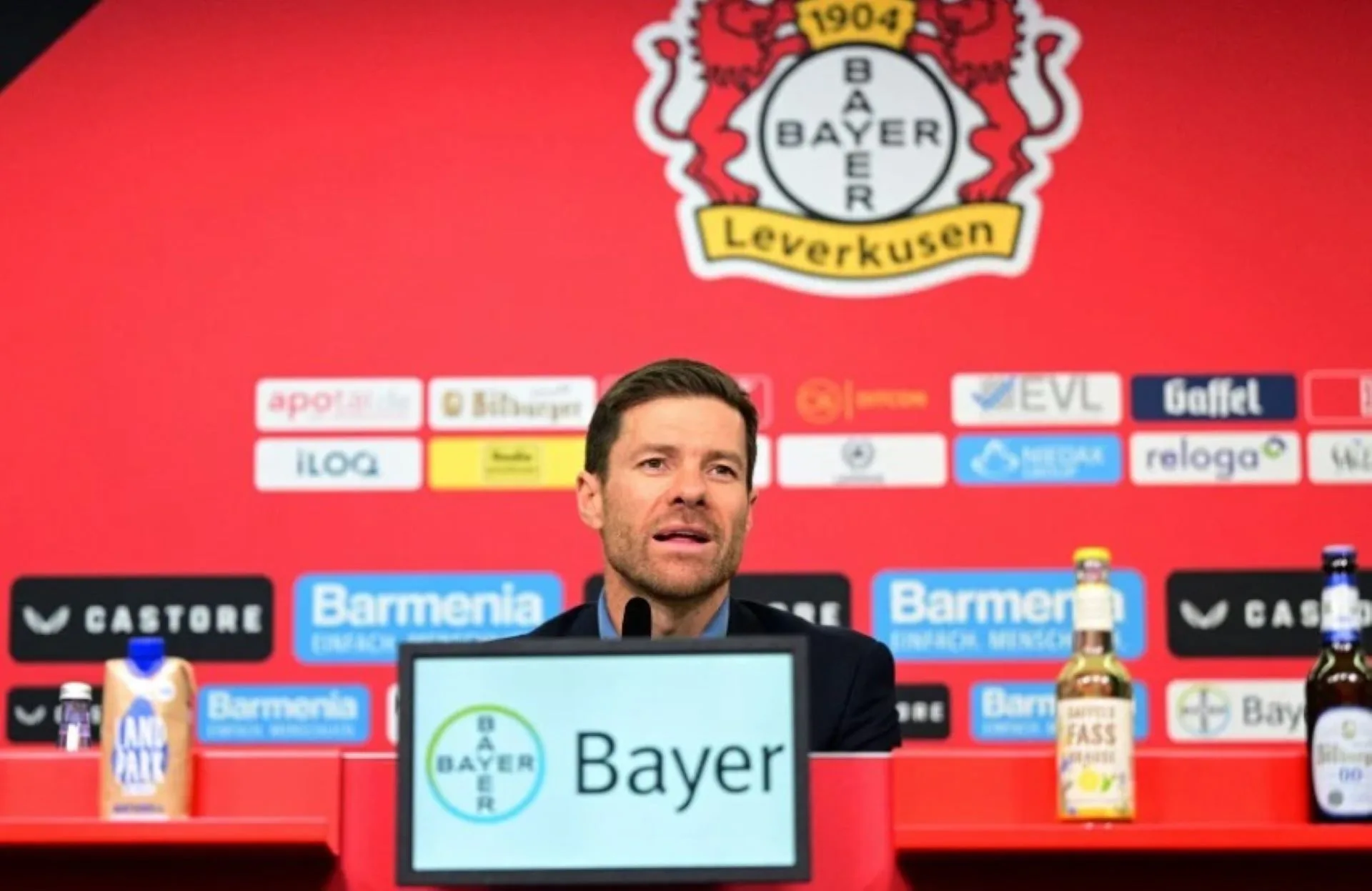
On 5 December 2022, Xabi Alonso took the helm. His appointment initially raised eyebrows due to his limited experience in top-tier management. However, Alonso rapidly dispelled any skepticism, radically turning around Leverkusen’s prospects.
Under his leadership, the club not only steered clear of relegation but also clinched an impressive sixth-place finish, earning a Europa League spot. Alonso even led the team to the Europa League semifinals, where they were stopped by his former mentor, Jose Mourinho.
This season, Leverkusen, under Alonso’s guidance, has surpassed Bayern Munich’s record of 24 unbeaten games, achieving an incredible 27-game unbeaten run. During this streak, the club has netted an impressive 85 goals across various competitions, showcasing their formidable attacking prowess.
Here is how Xabi Alonso has done this:
Formation
Leverkusen’s primary formation, a fluid 3-4-2-1, is anything but static. It smoothly transitions into a 4-2-3-1 or even a 5-3-2, showcasing the team’s impressive tactical versatility.
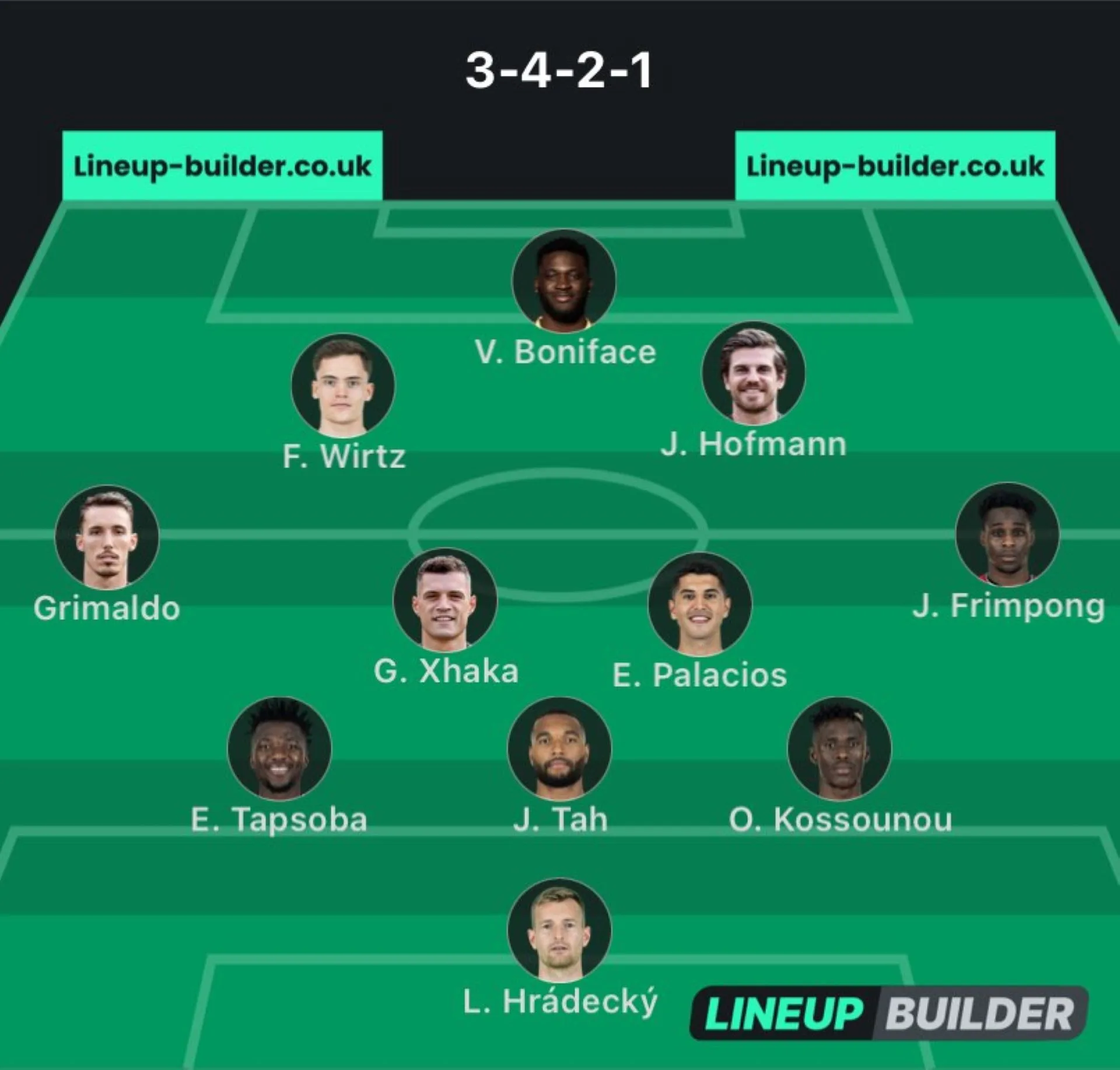

In Possession
In possession, Leverkusen often employs a 3-4-3 formation during the build-up phase. This structure sees the wingbacks stretching the field while Hofmann or Wirtz drop into central positions. Yet, when Xabi Alonso aims to intensify the game’s rhythm, Leverkusen shifts to a 2-5-3 build-up.
In this structure, Odilon Kossounou steps into the right wing-back role, allowing Frimpong to advance as a right winger. The team initiates play by circulating the ball between the back two and the central midfield duo of Xhaka and Palacios, deliberately luring the opposition’s press.
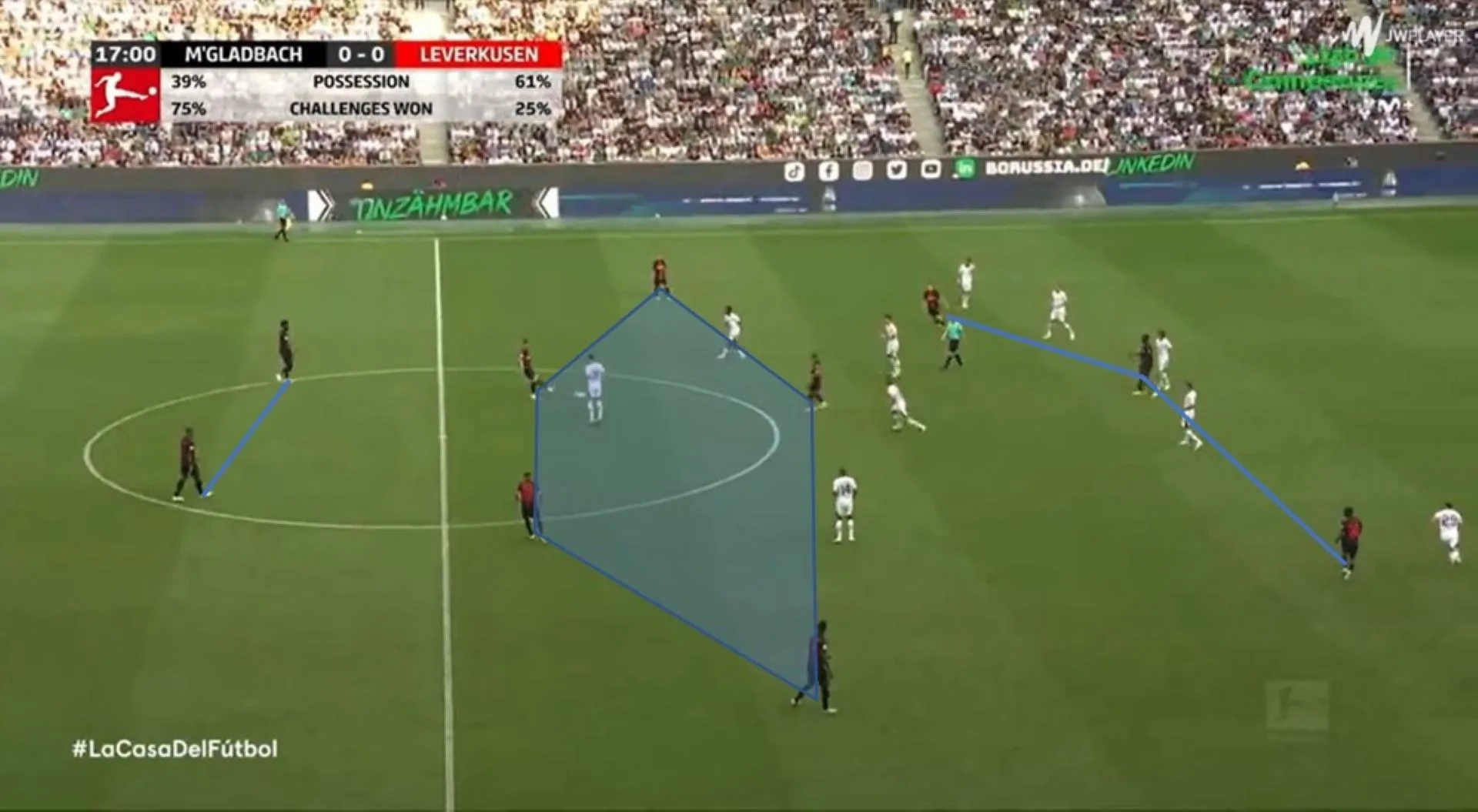
This tactic of drawing in the opponent’s press is designed to disrupt their defensive structure, consequently creating valuable spaces for Leverkusen to exploit. The team then advances up the pitch either through swift combinations in the midfield or by long switches to the wingbacks, who maintain the team’s width. These maneuvers effectively shift Leverkusen’s build-up from their own half to the attacking third, showcasing their strategic depth and offensive ingenuity under Alonso’s guidance.
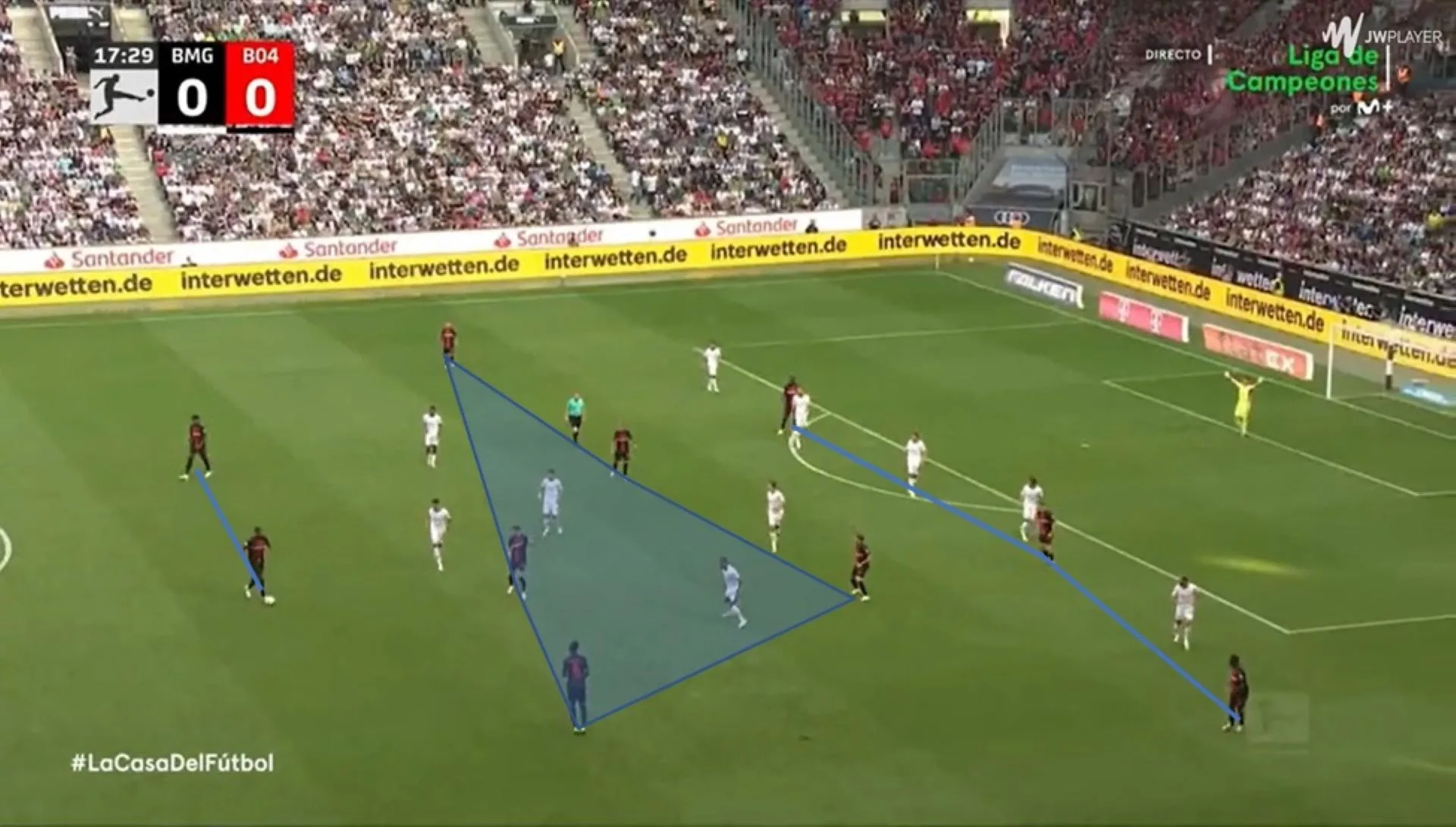
Patience is Key
Leverkusen exhibits remarkable patience in their build-up, with all players demonstrating technical prowess and the ability to pass both securely and progressively. Under Xabi Alonso’s leadership, the team leads the Bundesliga in open-play sequences involving 10 or more passes, boasting an impressive 405 such sequences. Moreover, they also top the charts with the highest pass completion rate at 87.2%, even while executing the second-highest number of progressive passes in the league.
This methodical ball circulation, gradually covering ground, is strategically designed to bait opponents into pressing. This tactic, in turn, opens up spaces between lines or behind the defense.
A prime example of this approach was evident in Leverkusen’s first goal against Borussia Mönchengladbach. In this instance, Alonso’s side orchestrated a passage of play lasting one minute and 20 seconds, seamlessly exchanging 25 passes.
This build-up culminated in Alex Grimaldo exploiting a gap with a well-timed run, ultimately assisting Boniface’s opening goal.
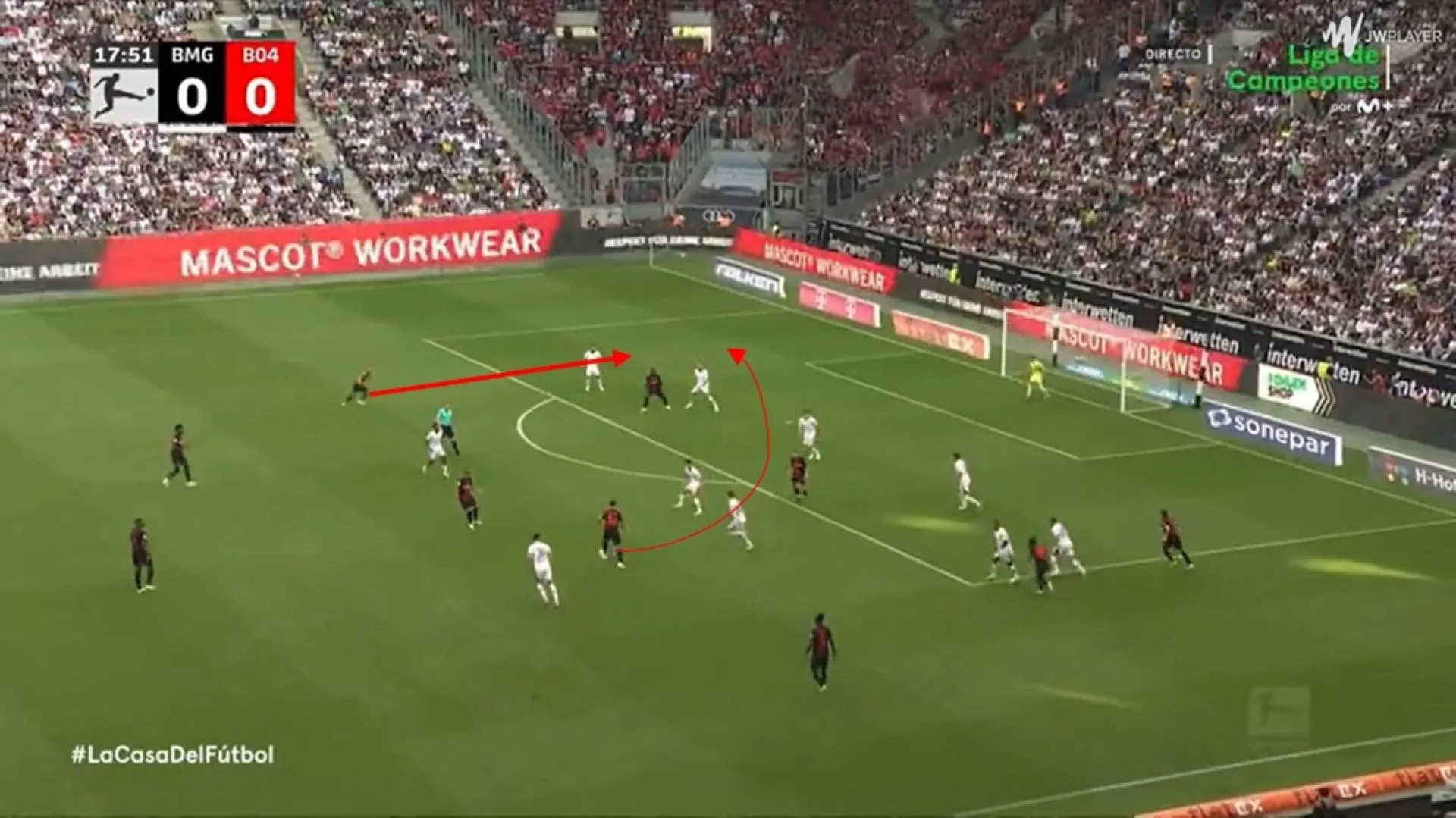
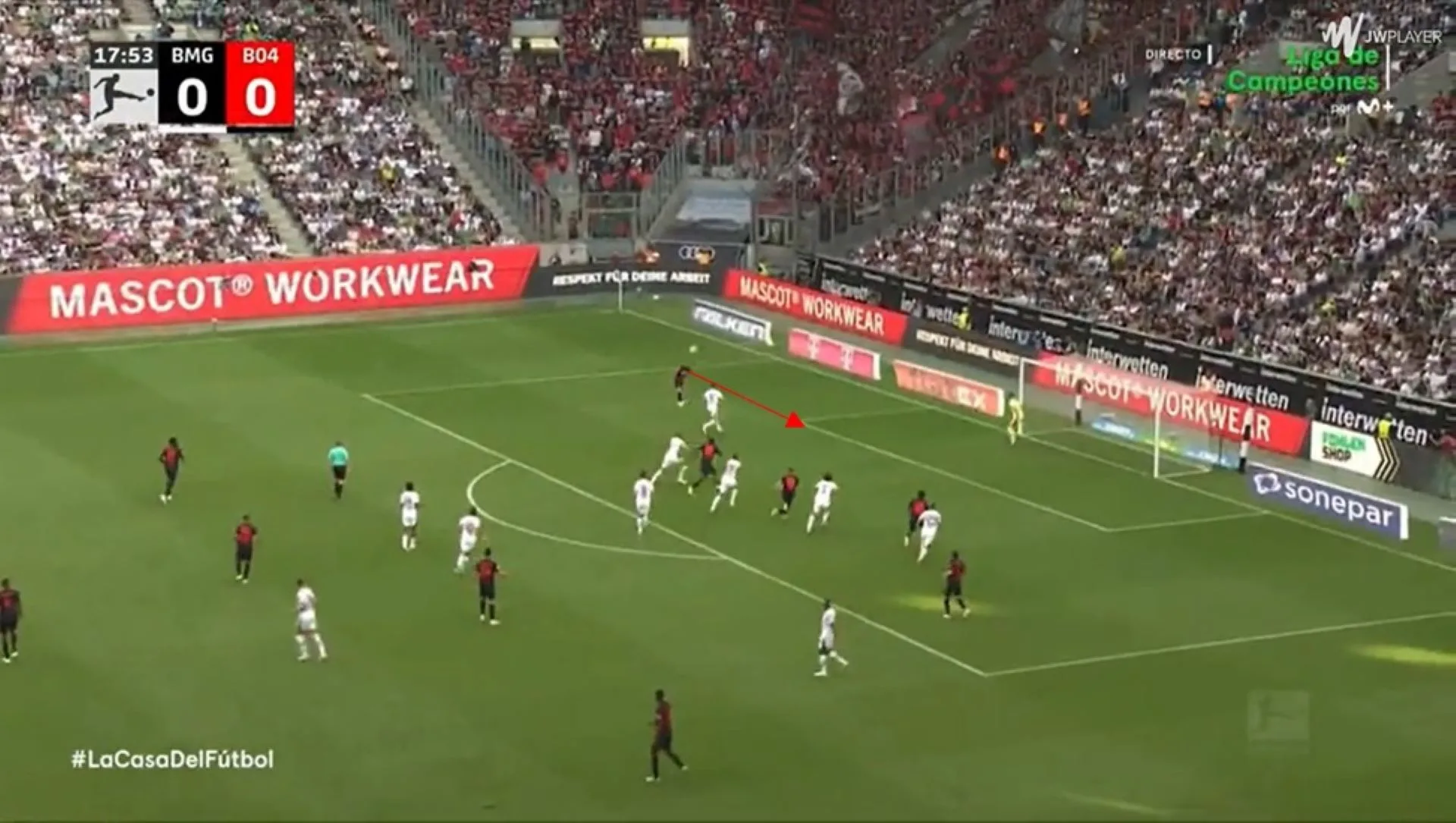
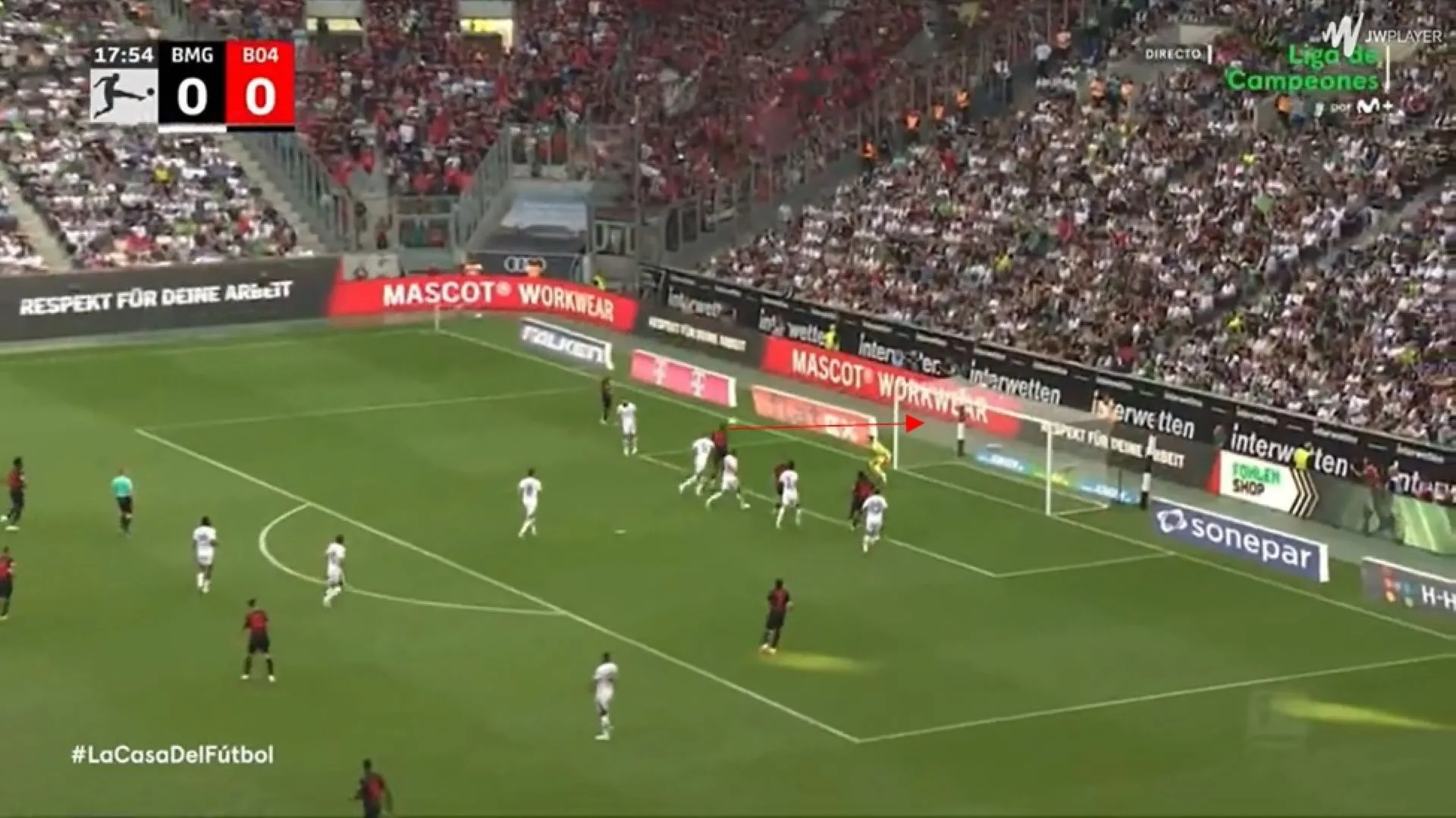
Leverkusen’s midfield, including the likes of Wirtz, shines in orchestrating plays and delivering precise passes, seamlessly integrating with the runs of their wingbacks. When Leverkusen’s unit establishes itself in the attacking third, a rapid exchange of passes ensues, complemented by strategic runs through the half-spaces.
This strategy significantly contributes to the impressive combined tally of 35 goal contributions from both Alex Grimaldo and Jeremy Frimpong across all competitions. Grimaldo, primarily a left-back, boasts an outstanding record of nine goals and 10 assists this season so far, outperforming many forwards in Europe.
What particularly distinguishes Leverkusen’s offensive strategy is the even distribution of their attacks. As noted by Luis Kircher, an analyst for Total Football Analysis, at one stage this season, their offensive forays were remarkably balanced: 29% initiated down the left flank, 20% through the inside-left channel, 18% via the inside-right, and 33% down the right flank. This equilibrium in attack presents a tactical confusion for their adversaries.
Concentrating on defending one particular area inevitably leaves others vulnerable, rendering Leverkusen’s offensive play both diverse and unpredictable.
Patiently Quick
Contrary to what one might assume, Leverkusen’s patient build-up doesn’t equate to slow attack patterns. Under Xabi Alonso’s guidance, whether the play develops through the central areas or along the wings, Leverkusen attacks with a blend of speed and precision, particularly noticeable in the final third. This approach is underscored by data illustrating Leverkusen’s efficiency in quick and voluminous ball passing, as depicted in the relevant graph.
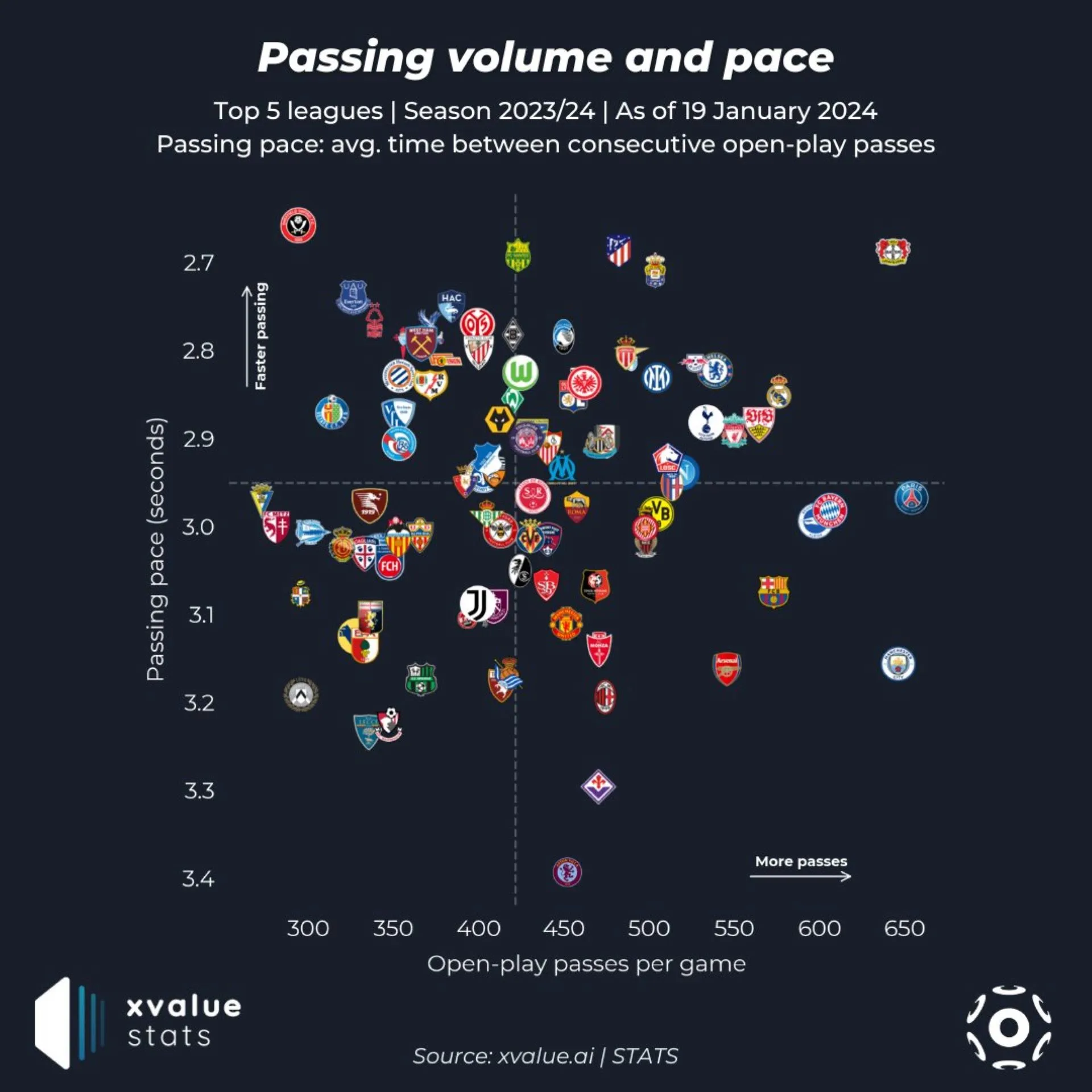
Efficient In Transition
Bayer Leverkusen’s strategy is not solely reliant on positional attacks. The team has also demonstrated proficiency in launching direct attacks from their own defensive third. A prime example was observed in their match against Eintracht Frankfurt. During this encounter, Florian Wirtz scored Leverkusen’s third goal, originating from a swift transitional play that began in their defensive area.
A decisive long kick from Lukáš Hrádecký, followed by skillful control and a pass from Victor Boniface, was enough to set Wirtz up for a one-on-one situation, leading to the goal.
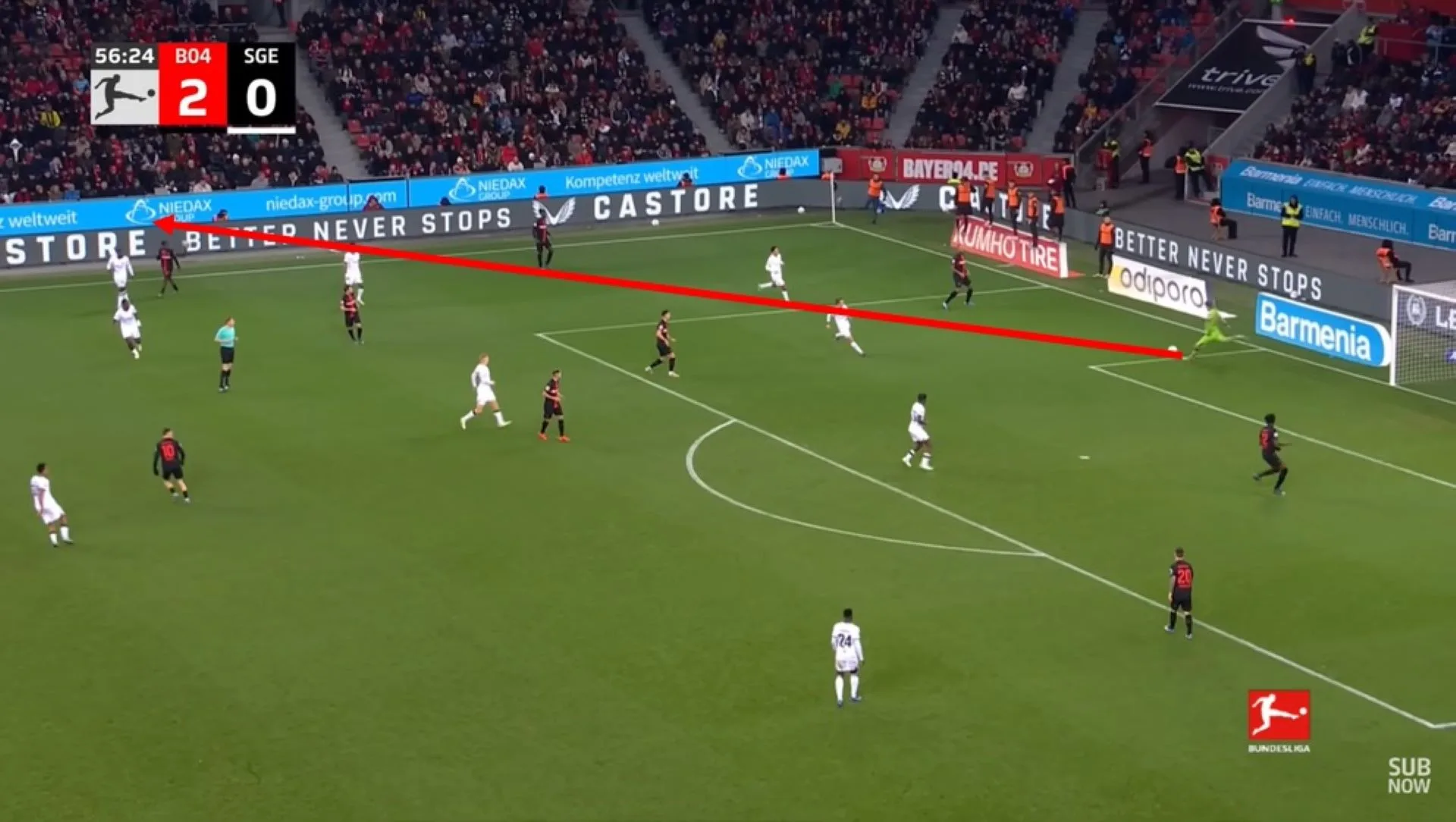
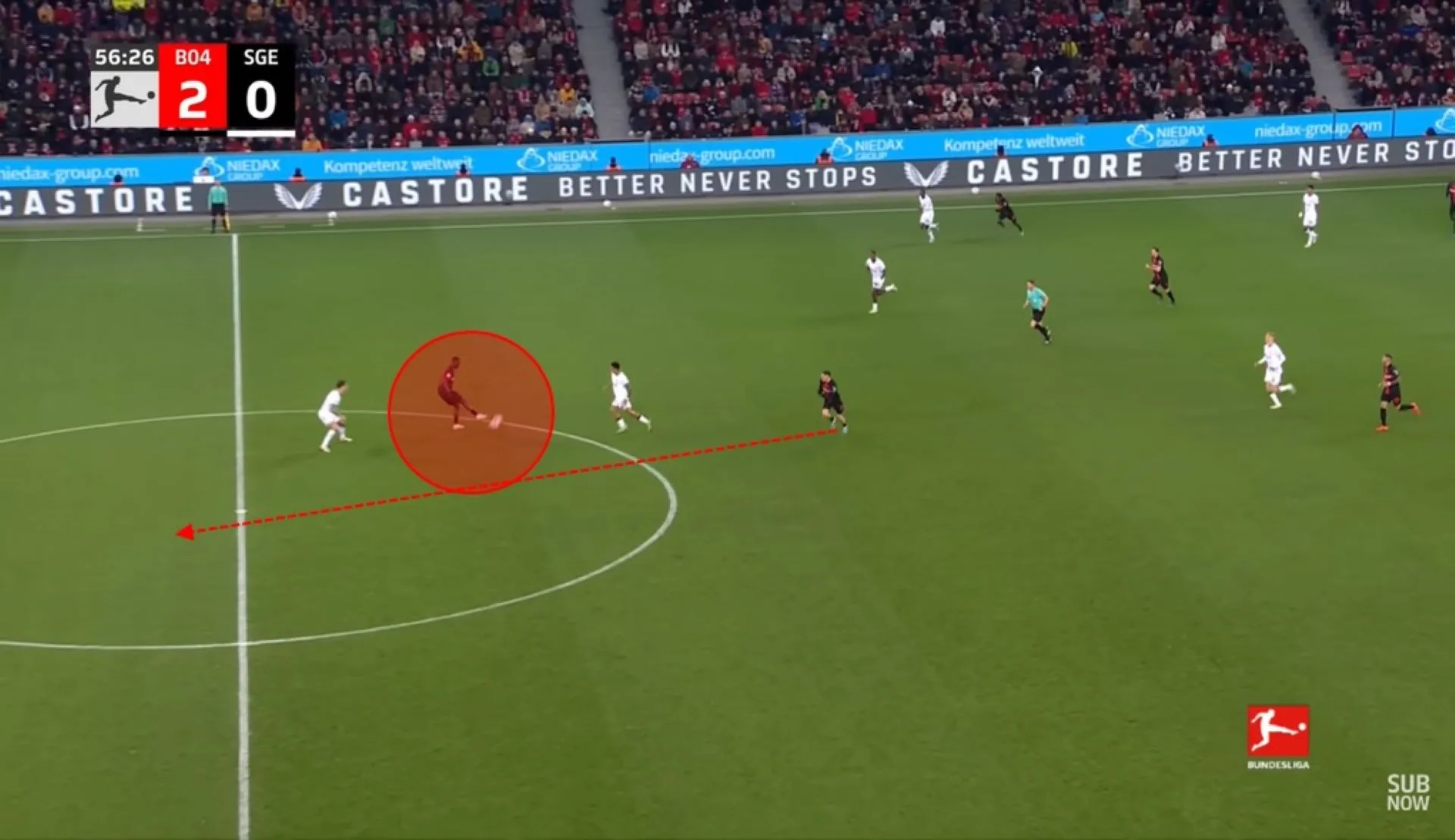
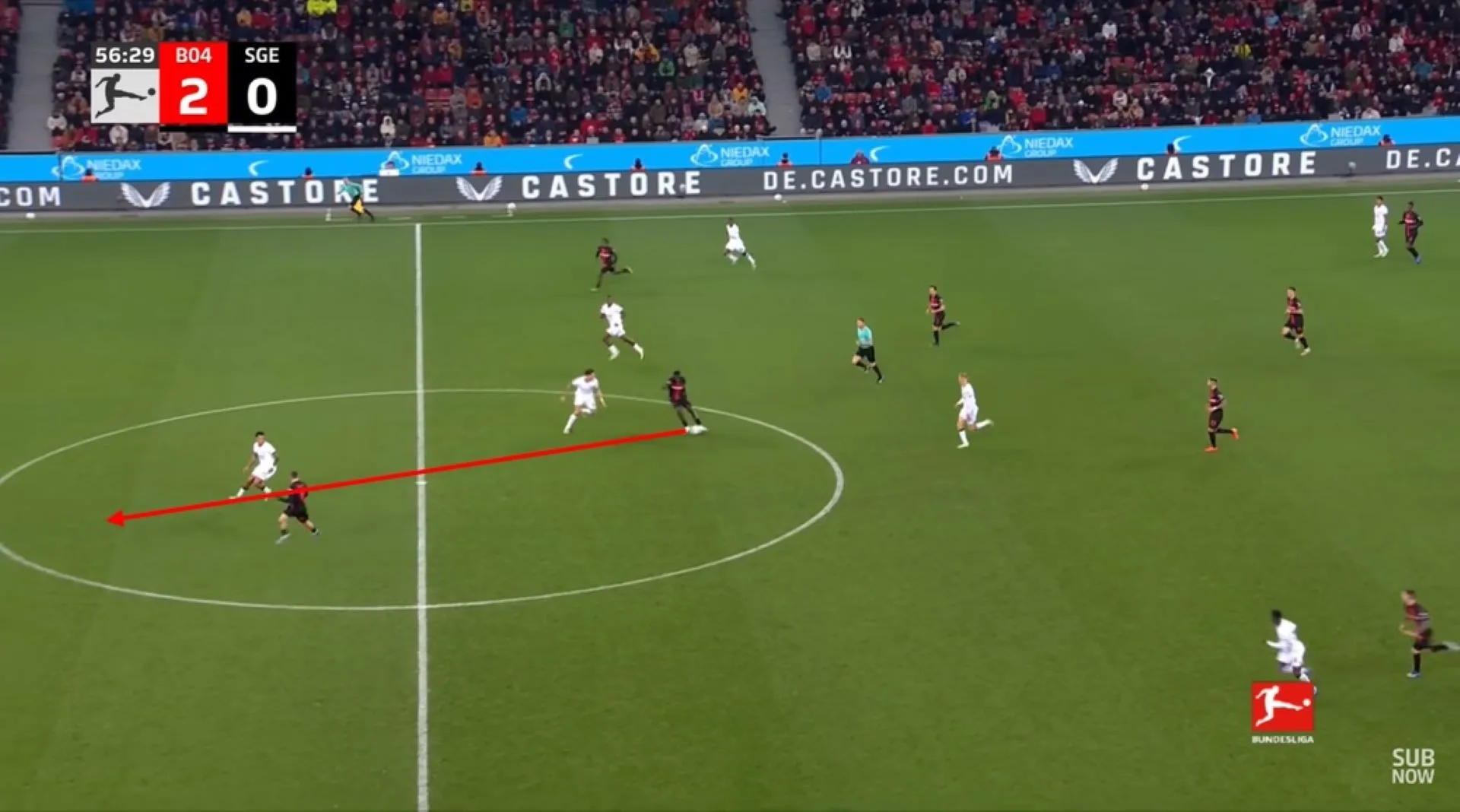
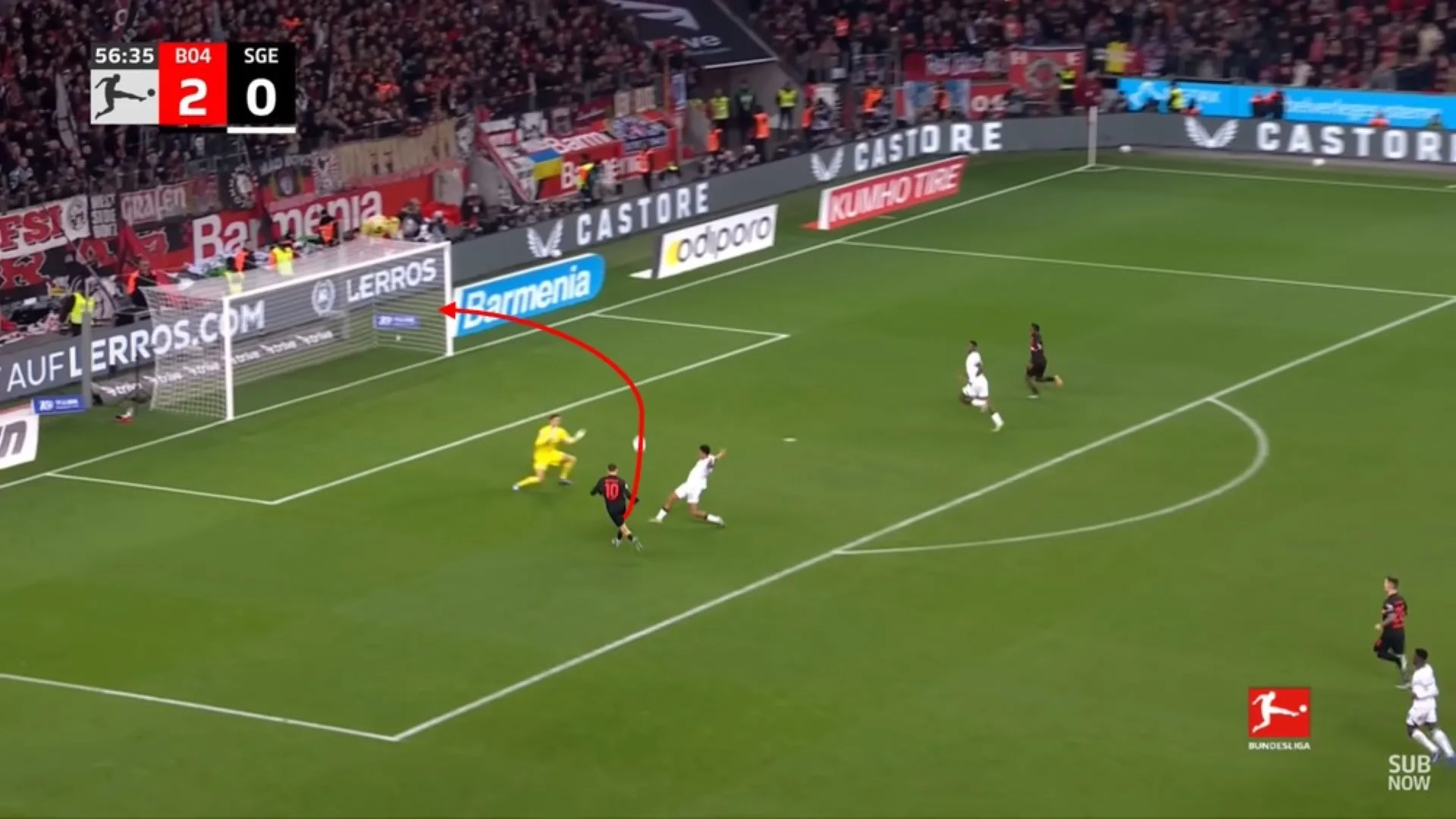
Out Of Possession
Press baiting, intricate combinations in central areas, transitions, and swift switches to advanced wingbacks are pillars of Alonso’s in-possession style. But what about their approach when out of possession?
Counter-Pressing
Bayer Leverkusen’s strategy without the ball is equally impactful, primarily due to their relentless counter-pressing. They rank as one of the top teams in the Bundesliga for tackles in the attacking third, with a total of 46. This impressive figure is a testament to their aggressive “Gegenpress” approach, aimed at regaining possession in the opponent’s half.
This method has positioned Leverkusen as the league leader in high turnovers, registering an impressive 191. Out of these, 36 turnovers have led to shots on target, showcasing their ability to convert defensive actions into offensive threats swiftly.
A notable instance of this strategy was evident in Leverkusen’s 2-2 draw against Bayern Munich, where their high-pressing approach was on full display.
Once Jeremy Frimpong lost the ball, he immediately counter-pressed Bayern’s defenders, forcing a pass back to their keeper. Victor Boniface targeted Bayern’s goalkeeper, Sven Ulreich, to cut passing lanes. Jonas Hoffman immediately anticipated Ulreich’s pass, resulting in a high turnover and a dangerous chance for Leverkusen.
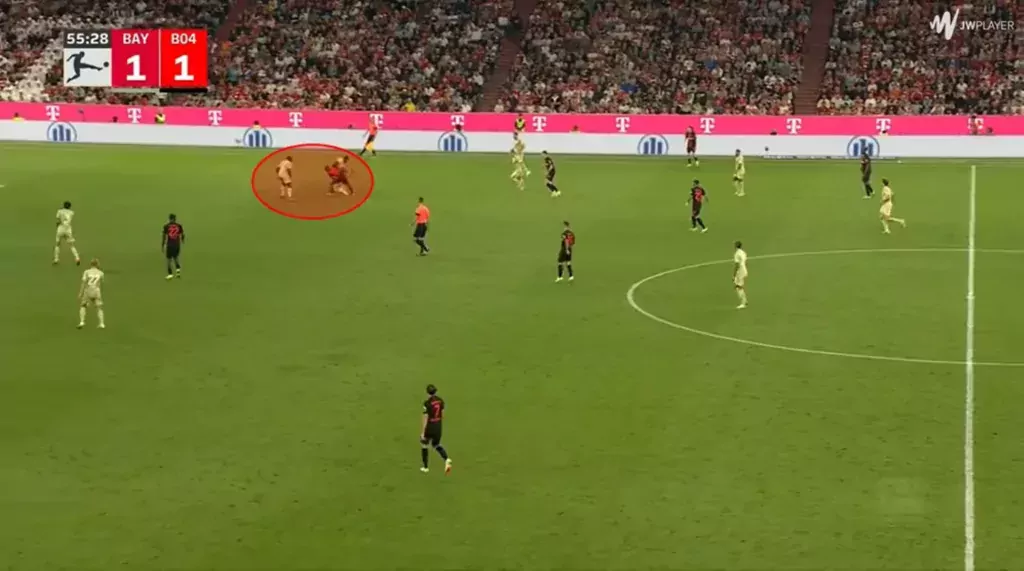
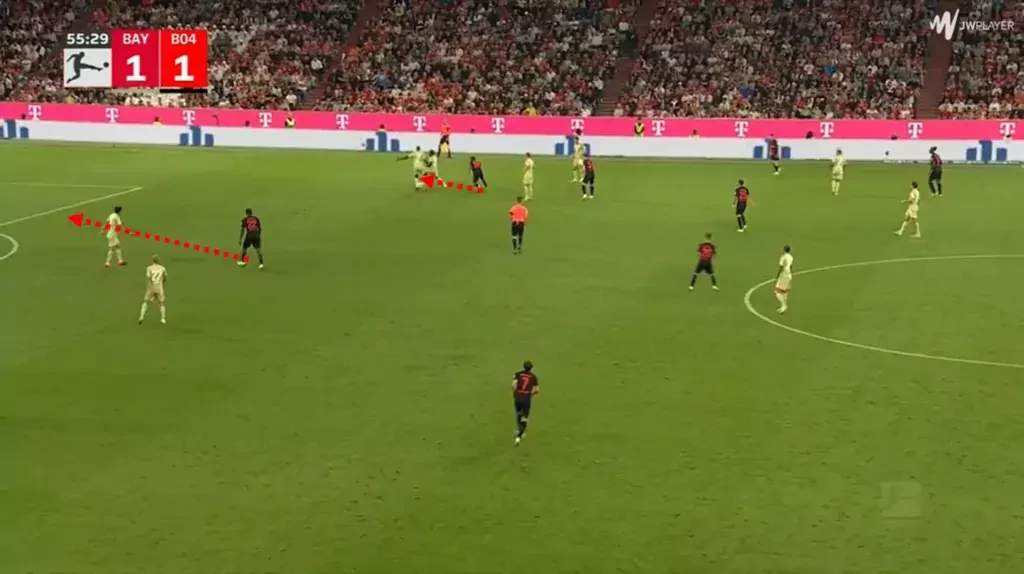
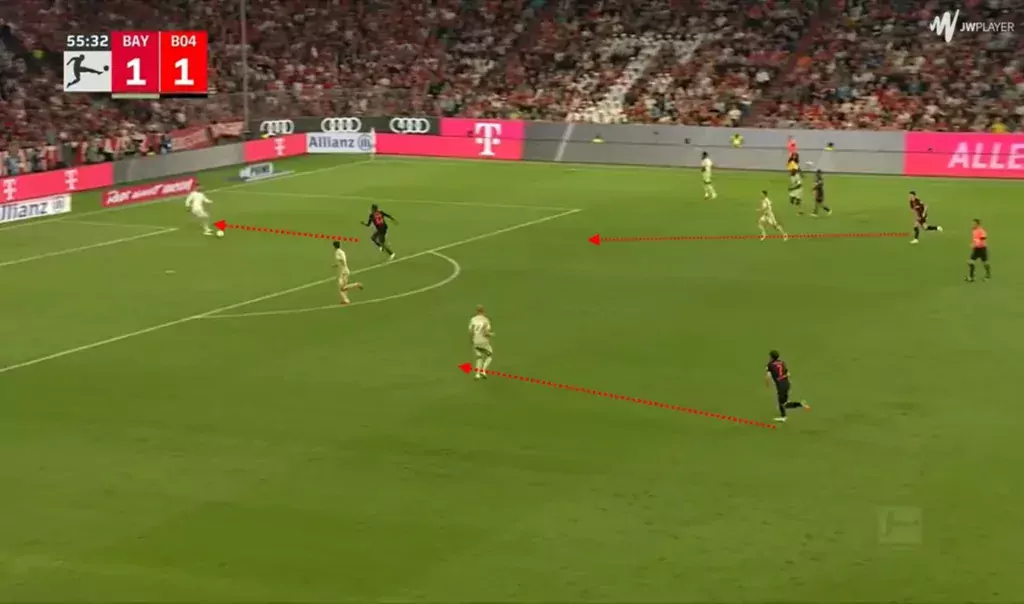
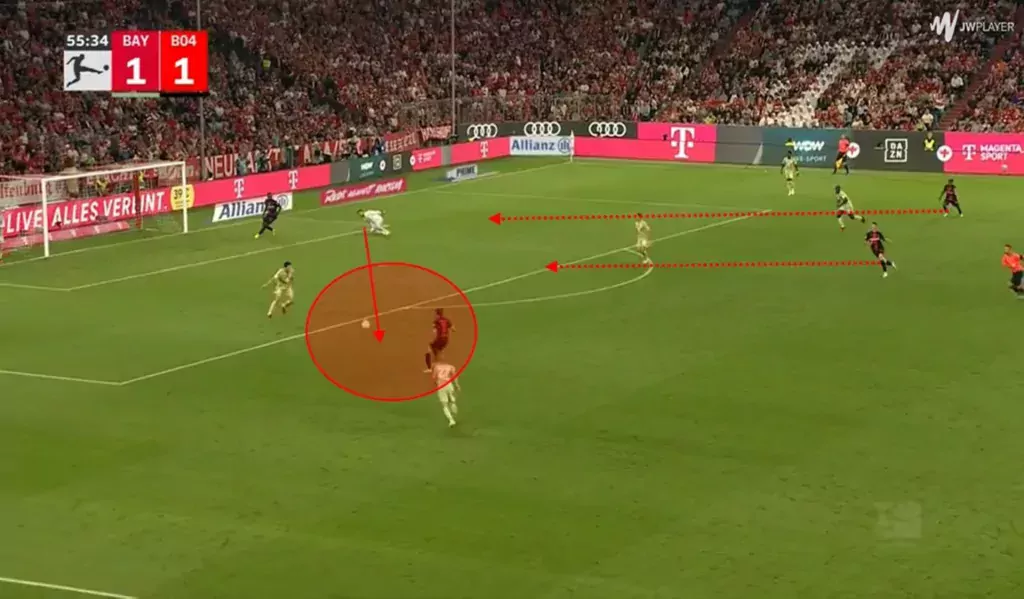
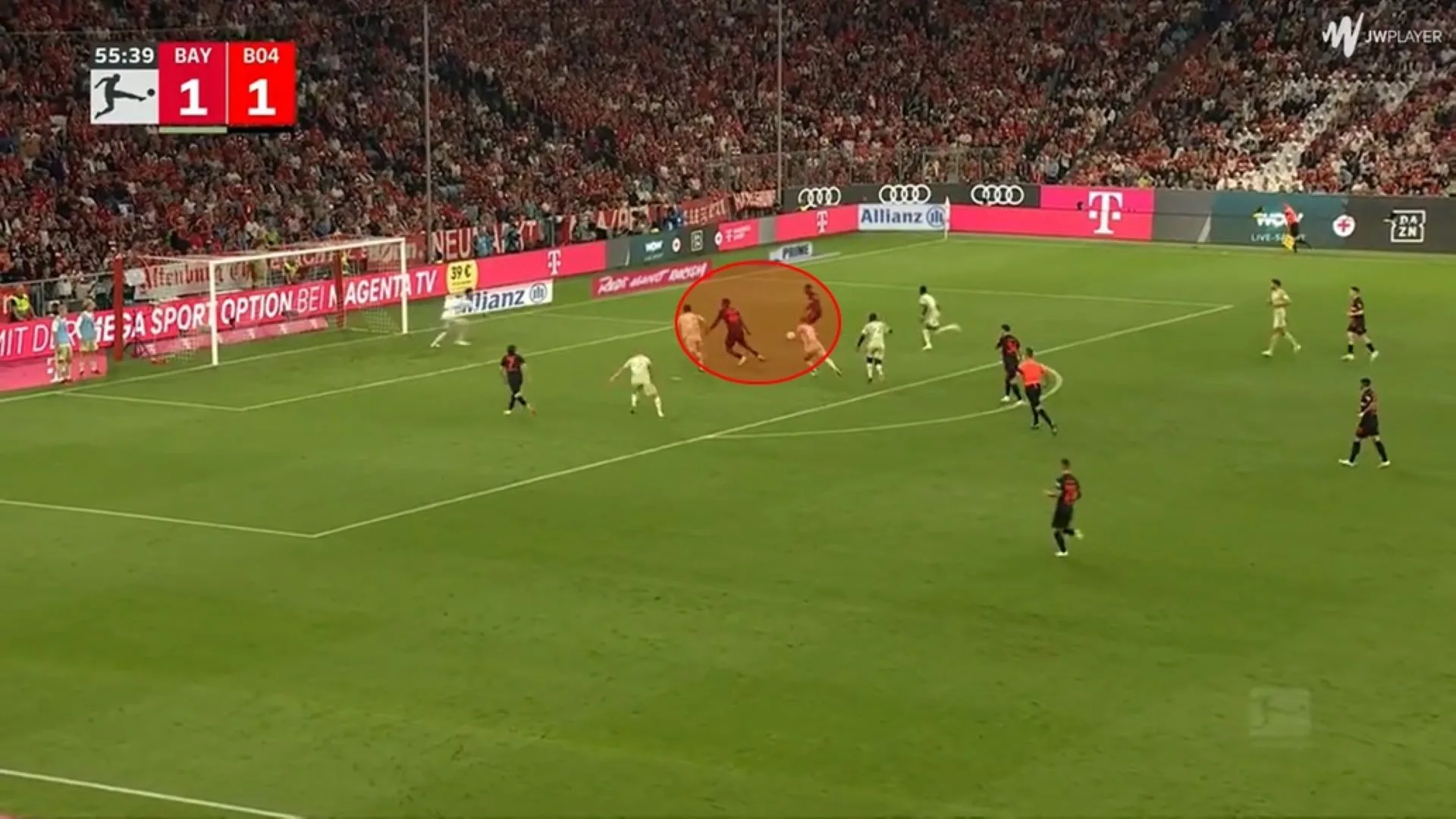
Defensive Structure
Indeed, a team cannot rely solely on counter-pressing. Thus, during an opponent’s build-up phase, Leverkusen typically adopts a 5-3-2 mid-block setup, with Kossounou and Palacios often interchanging roles. Upon regaining possession, Leverkusen immediately switches to a quick counter-attack, looking to exploit the advanced positions of their wingback, who surges upfield the moment the ball is won.
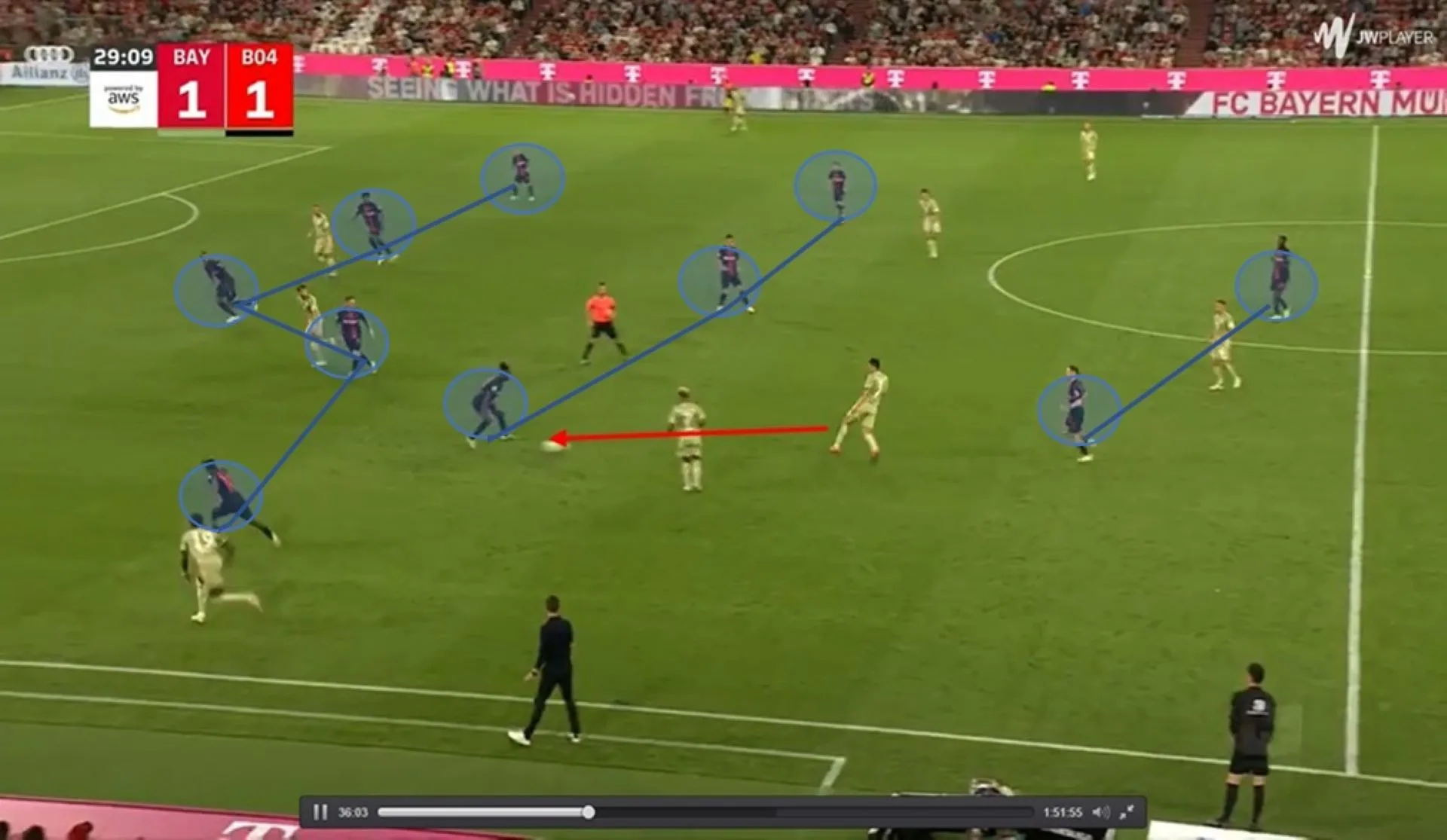
Take, for instance, their approach against Bayern Munich, where Kossounou adeptly moved into the pivot position to cover spaces effectively. He helped regain the ball after anticipating Kim’s pass and winning his consecutive dual. Wirtz initiated the counter-press, taking the ball off the South Korean before passing it to his teammate, who launched the counterattack with a ball to the advancing Grimaldo, who threaded the ball towards Hofmann in the final third..
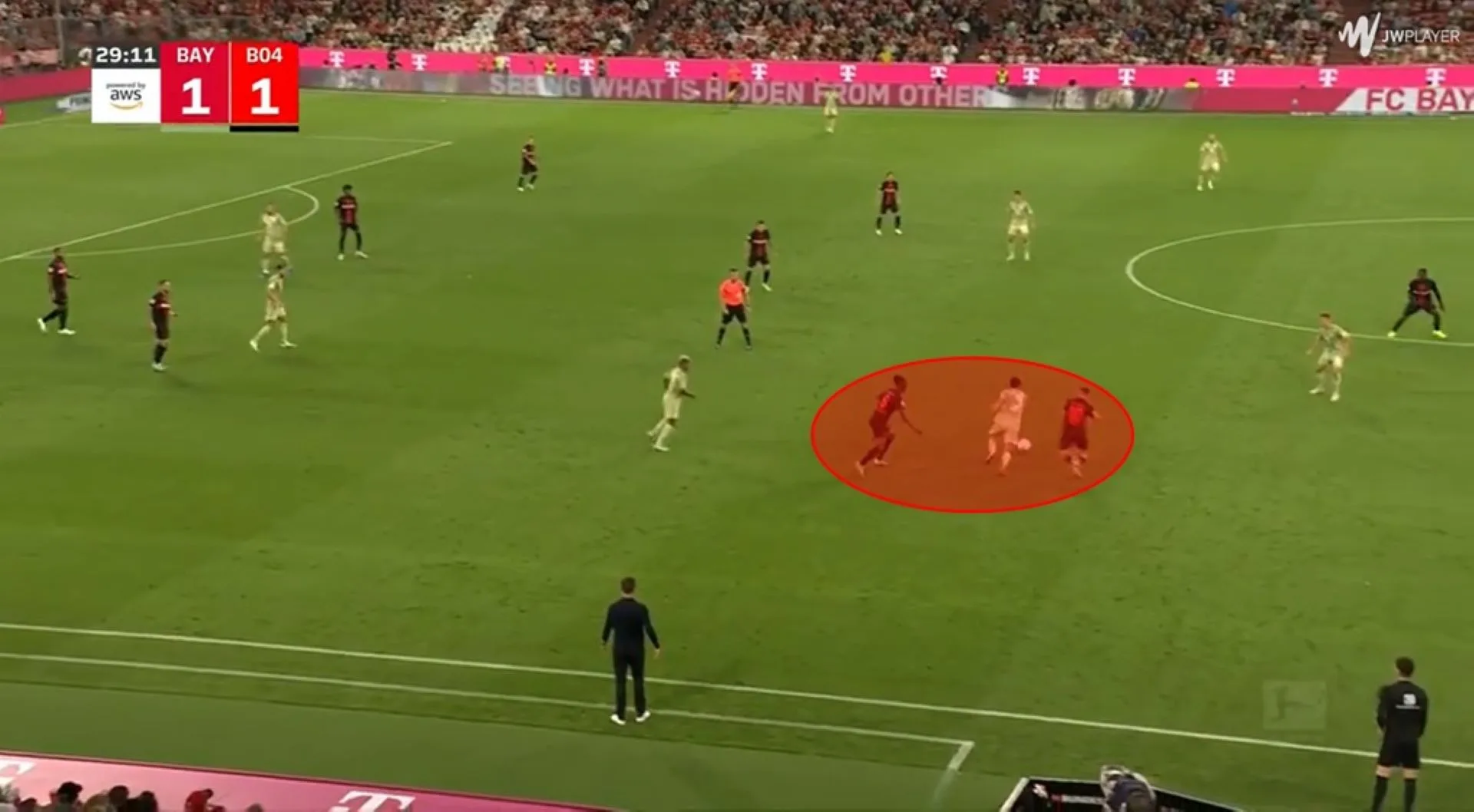
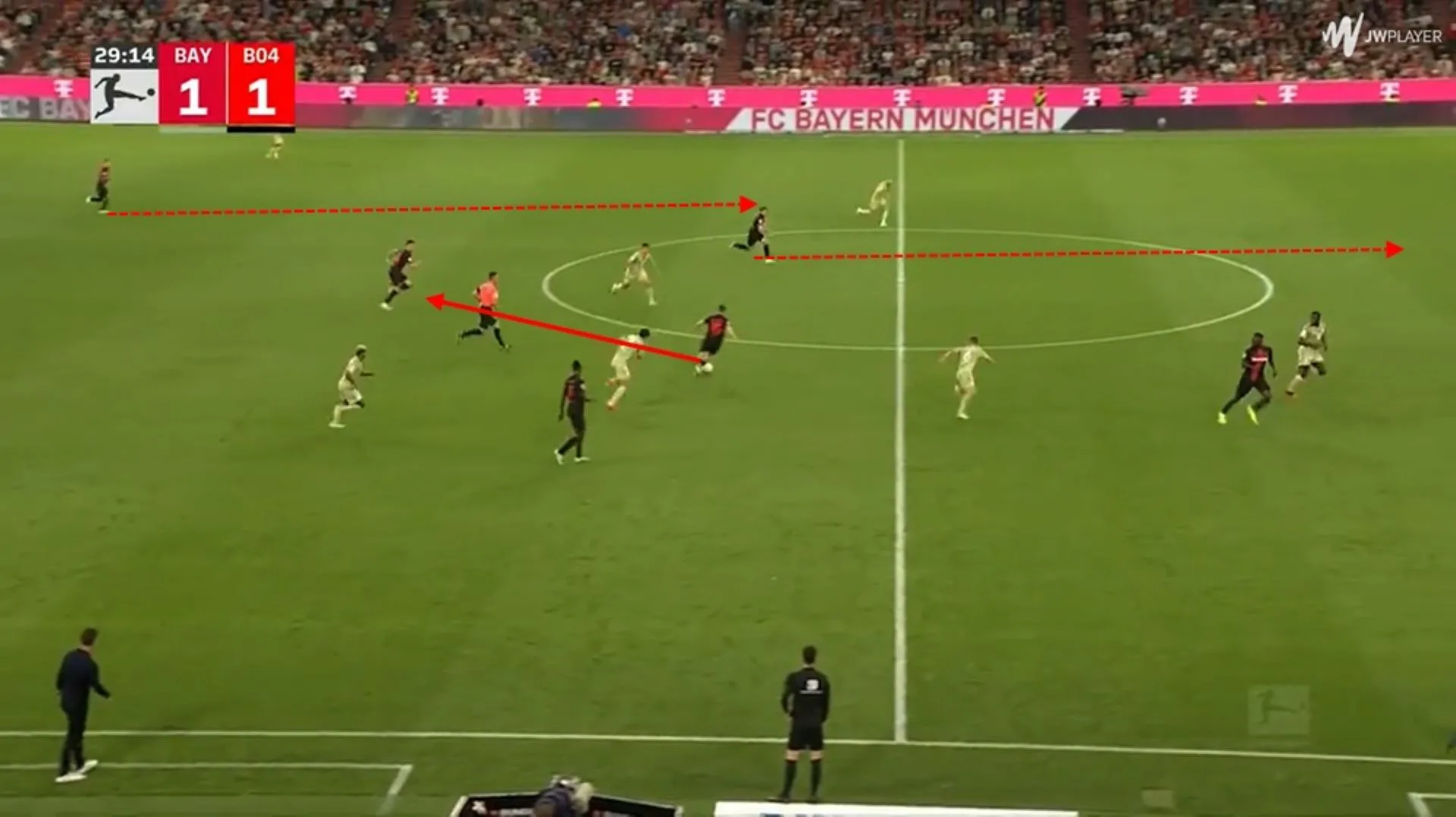
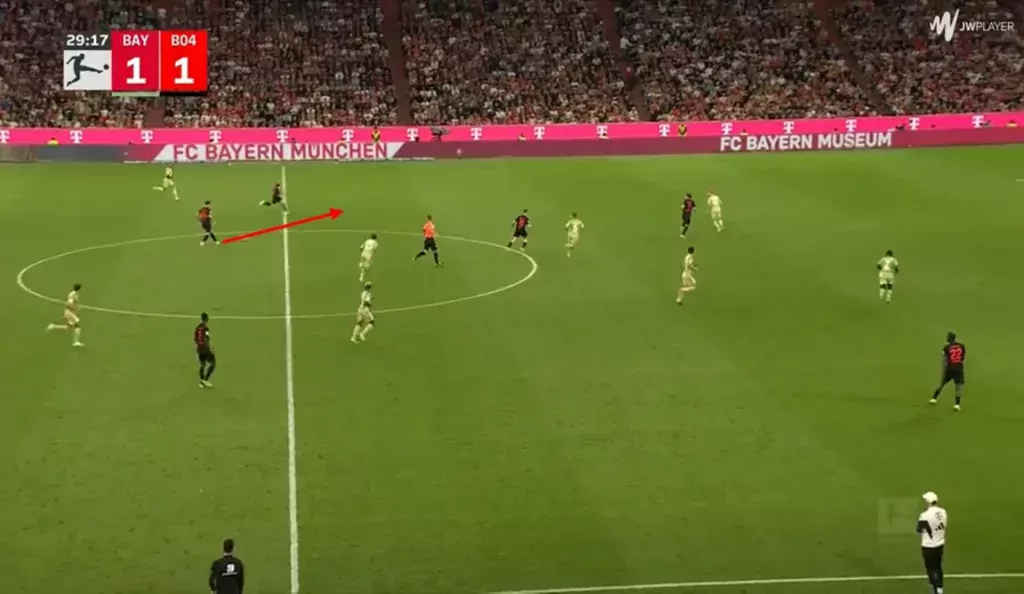
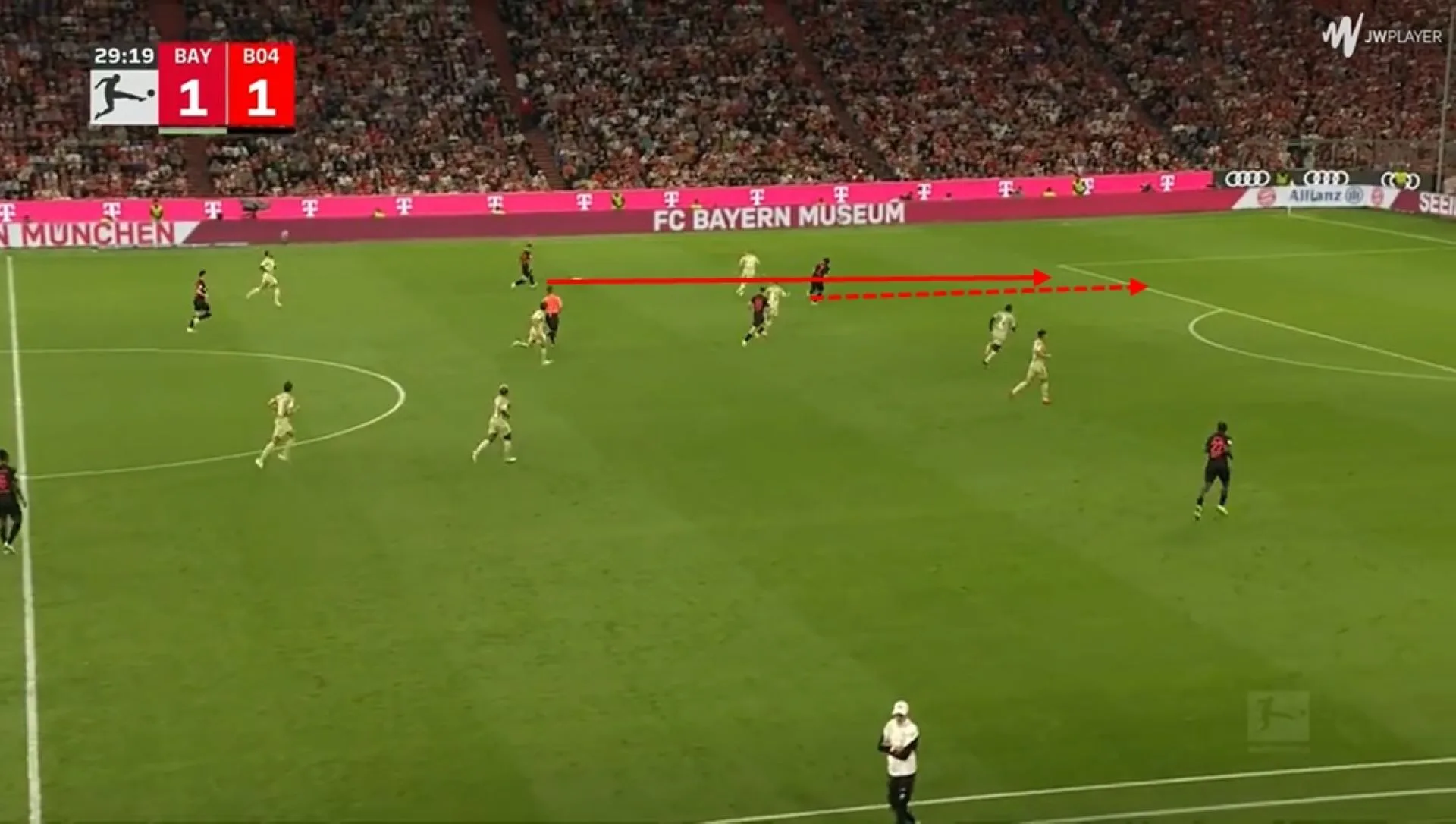
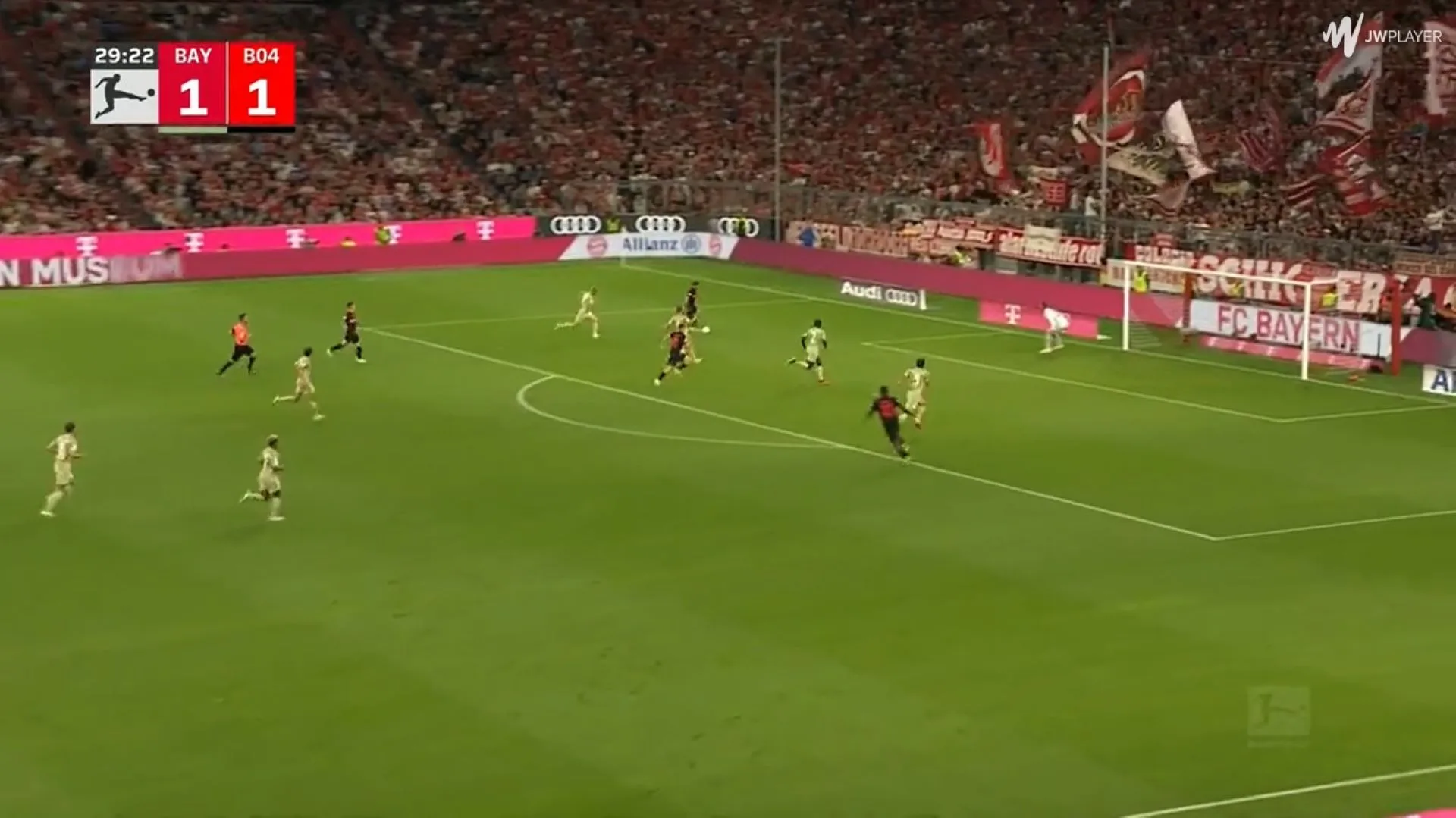
The three-man defensive line, comprising Tah, Tapsoba, and Kossounou, equips Leverkusen with the necessary physicality and athleticism. This setup enables them to win duels, rapidly cover spaces in rest defense, and dominate aerial challenges.
This cohesive defensive block, coupled with the double pivot and retreating wingbacks, is a key factor behind Xabi Alonso’s team having the league’s most formidable defense, conceding a mere 14 goals.
Why Xabi Alonso is Ideal for Liverpool Rather Than Real Madrid
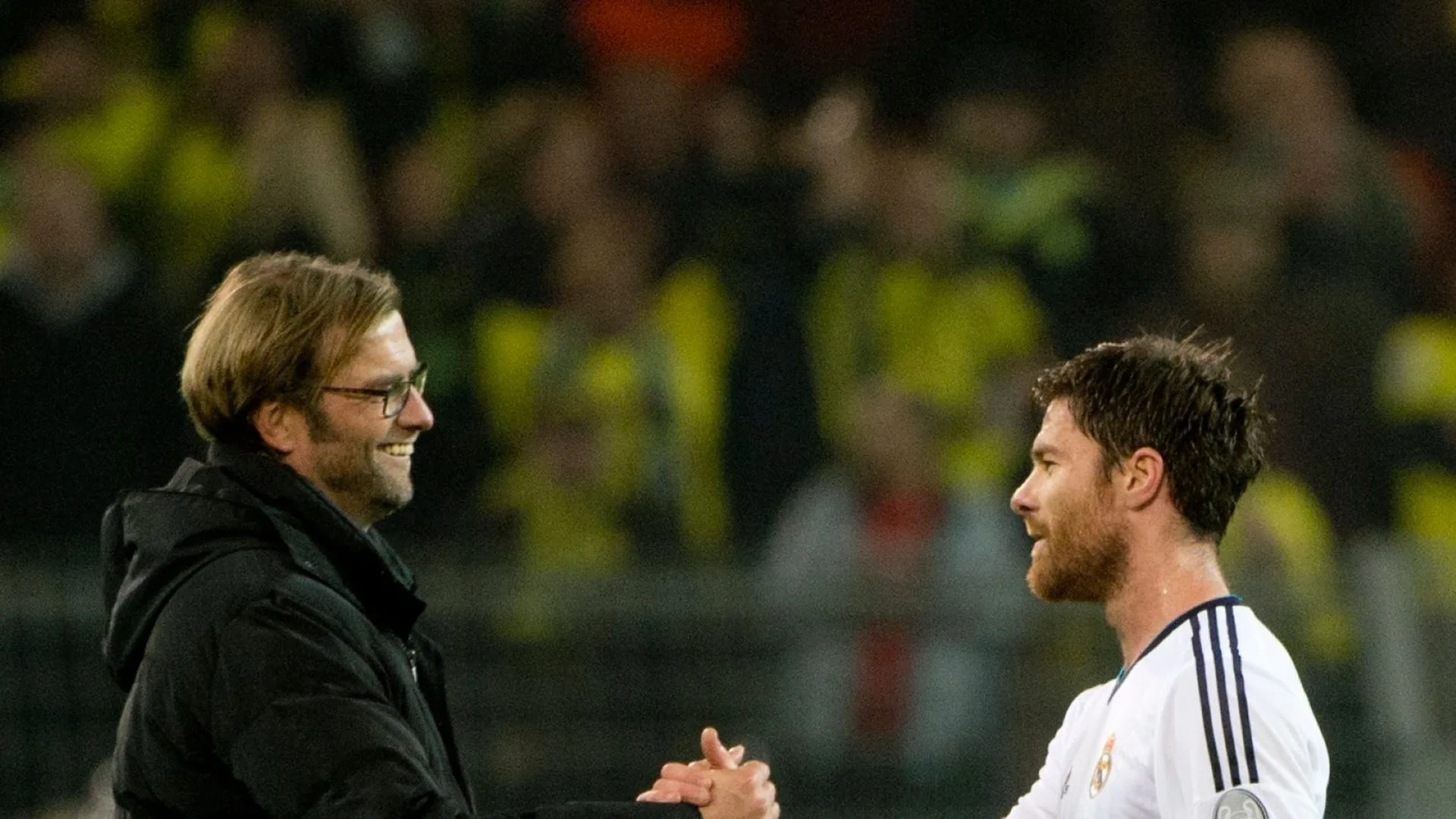
Xabi Alonso, having refined his managerial acumen under football luminaries like Pep Guardiola and Jose Mourinho, has evolved a style of football that is impressively comprehensive. However, it’s the parallels between his tactics and those of Jurgen Klopp at Liverpool that are particularly striking. The strategic playing through lines, leveraging full-backs for attacking impetus, and robust counter-pressing – these are trademarks of Klopp’s Liverpool. This tactical similarity is the primary reason why Alonso would seamlessly fit into the Anfield setup.
For a club like Liverpool, preserving its identity through managerial transitions is essential. Since Klopp’s tenure began in 2015, the Reds have been emblematic of a high-energy, pressing football style. Alonso’s similar approach indicates he would not only respect but also build on the team’s existing dynamics and philosophy, promising a smooth transition in case of a managerial change.
In contrast, Real Madrid’s style is characteristically fluid, often revolving around the unique abilities of its star players. This contrasts markedly with a system-centric approach where the overarching strategy is paramount. Alonso, favoring a more structured and consistent style, may find the adaptable, star-centric approach at Madrid less aligned with his philosophy.
Additionally, the culture at Real Madrid, with its emphasis on immediate success and consistent trophy wins, places enormous pressure on managers. Alonso’s developmental approach, which focuses on nurturing a team over time, might not align with Madrid’s expectation of instant results.
Conversely, Liverpool has shown patience with Klopp, notably during his initial years and even after the challenging 2022-23 season. The same scenario at Real Madrid might have resulted in a managerial dismissal.
Liverpool Under Xabi Alonso
Envisioning Xabi Alonso at the helm of Liverpool for the 2024-25 season, one can foresee this setup as a perfectly tailored first eleven, effectively translating his philosophy into the Premier League.
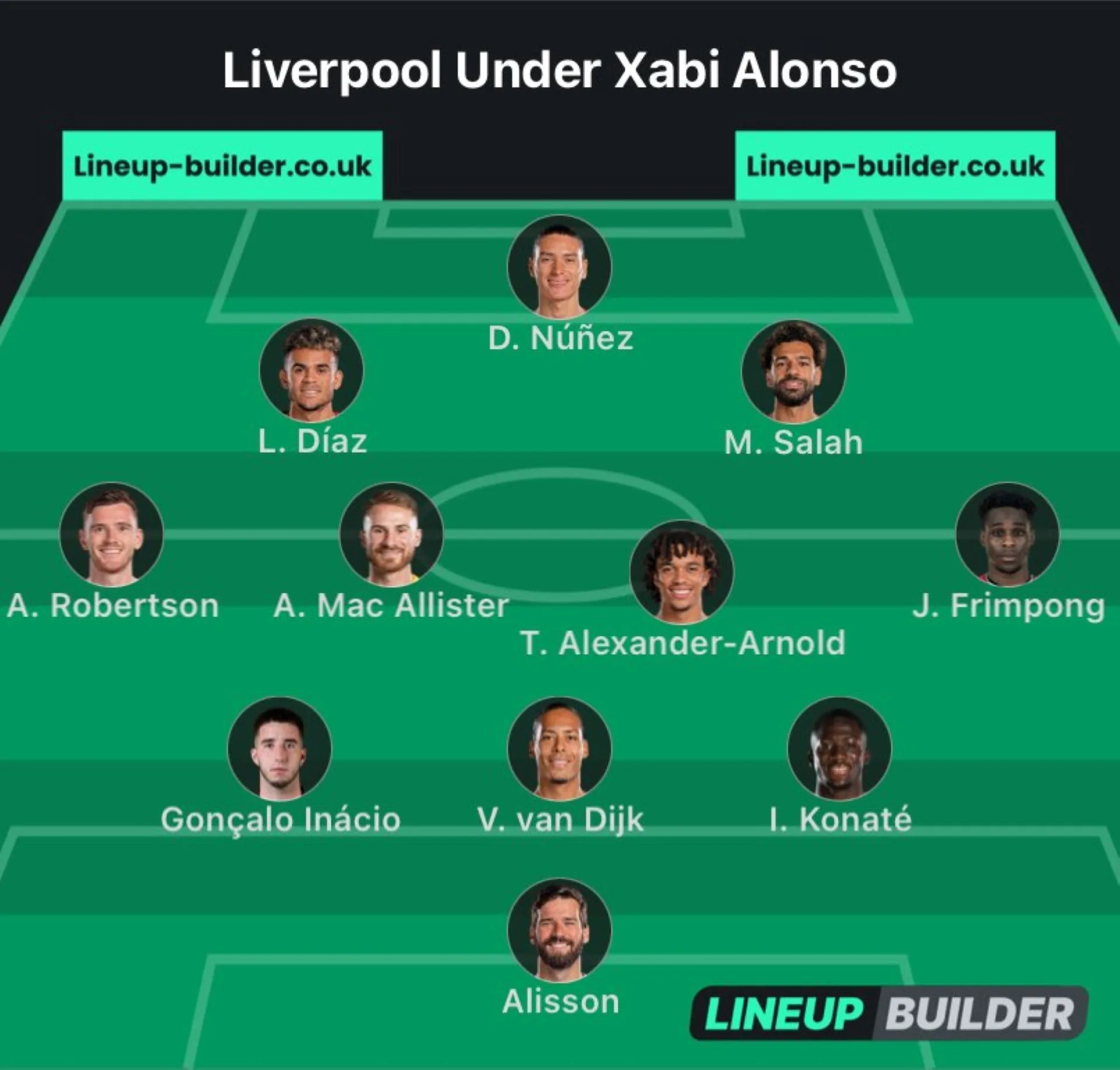
However, the allure of a prestigious club like Real Madrid, especially with Carlo Ancelotti’s potential departure, might tempt Alonso to return to the club where his managerial journey began.
But as of now, Liverpool seems to be the best destination.


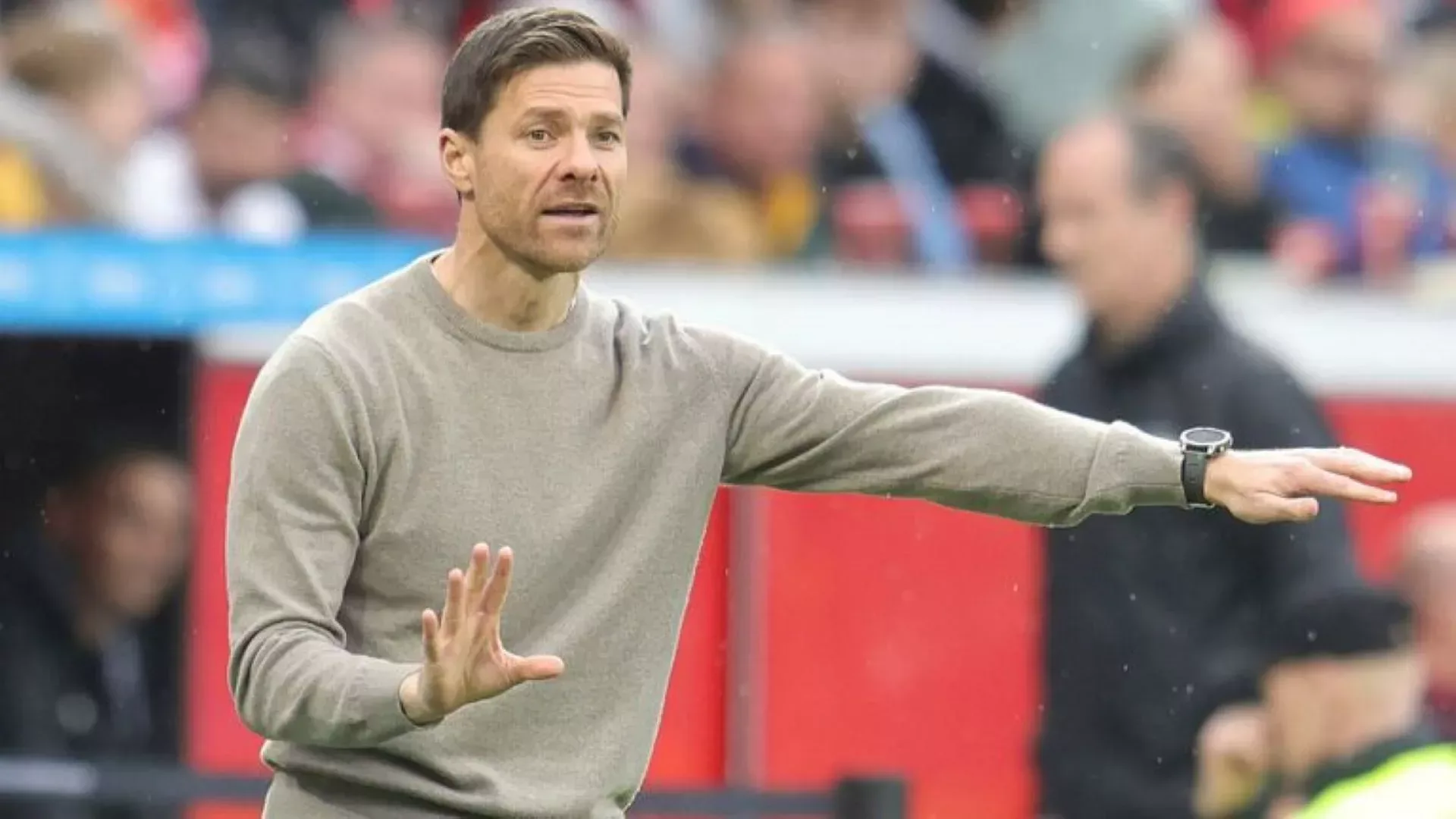
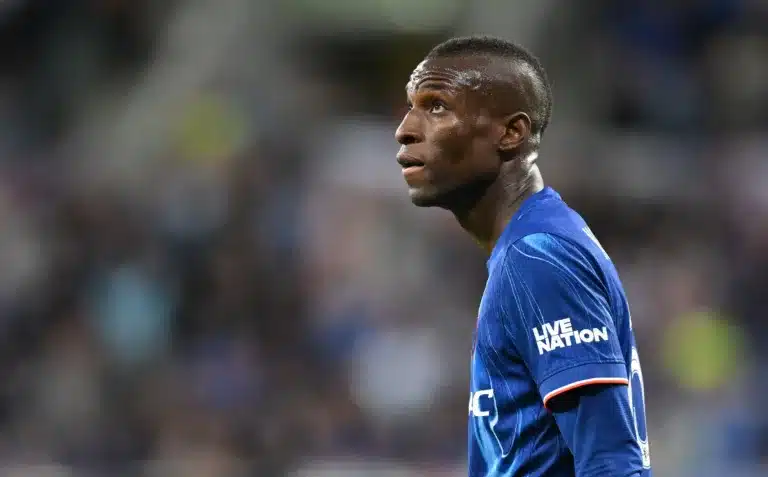
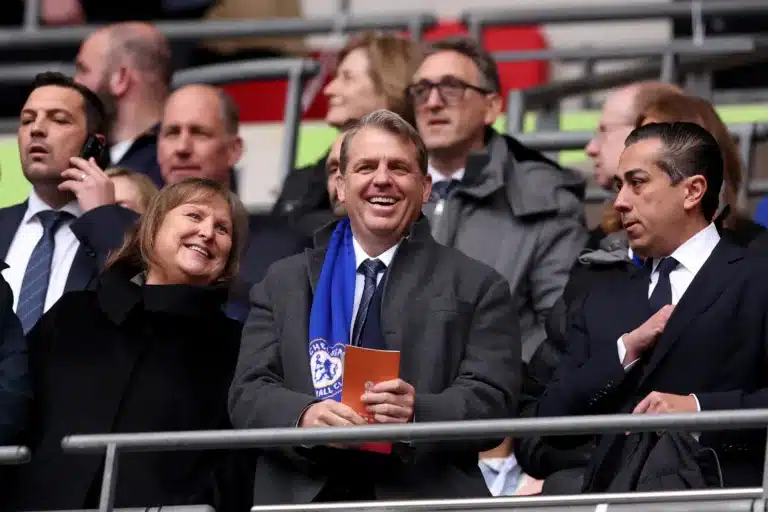
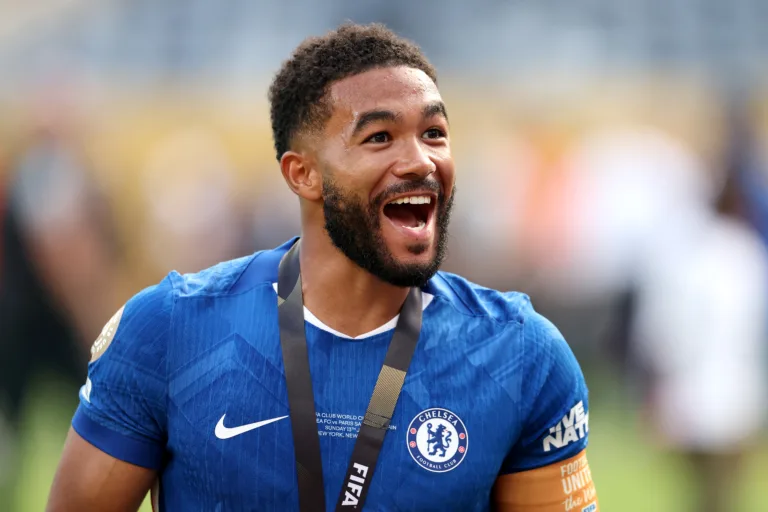
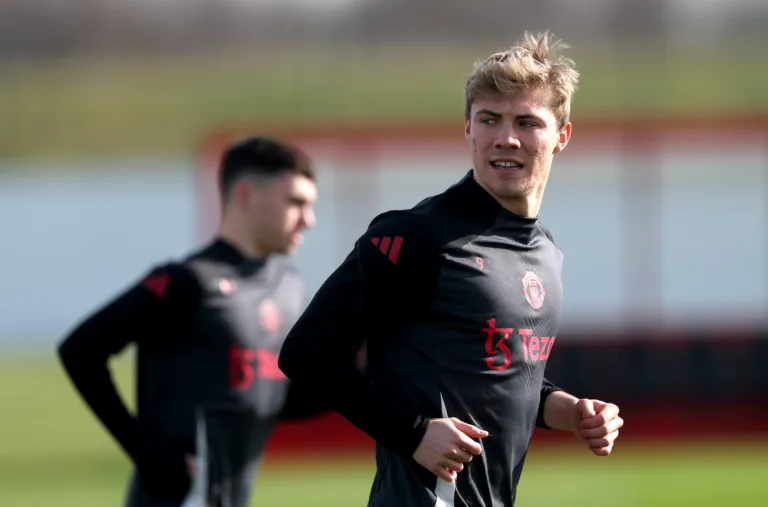


4 Comments